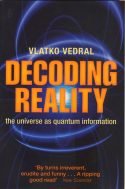
OUP
ISBN 978-0-19-969574-4
Quantum physics will always baffle our intuitions, and pop science books trying to explain it will always be written, often by excitable physicists keen to spread their philosophical wings.
The flapping noises that this produces may greatly reduce any excitement for the reader. Let us begin, then, with some irritation, by considering the Via Negativa, or negative way, at Vedral’s invitation. This approach was favoured by the Cappadocian Fathers of the 4th century, who tried to elucidate what God was by focussing on what he wasn’t. When Vedral says things like, “the Cappadocian Fathers reach [sic] the ultimate knowledge of God in the same way that we reach the ultimate understanding of reality” (p.195), it seems reasonable to apply this negative way to his book.
A reliable account of the universe may not be one that says, “to a scientist, any knowledge always refers to the knowledge of the future. Hence historians are not scientists…” (p.19) Bad news for geologists, palaeontologists and cosmologists.
Does I = log 1/p mean that information, the keystone of the book, is “proportional” to log 1/p (p.29)?
Vedral says we can calculate the information-carrying capacity of any object by using its area and mass. Thus, “a typical head is 20 centimetres in diameter and weighs 5 kilograms. That means that a typical human head can store 10 to the power of 44 bits of information. Compare this to the best current computers which are still only of 10 to the power of 14 bits of information” (p.185). No mention here of a computer’s area or mass. Might we compare the information-carrying capacity of Vedral’s head and a particularly large turnip?
There are many questionable remarks throughout the text, but those concerning the “reality” Vedral purports to decode invite the most negative verdict. At the outset he states that “we create our reality through our understanding of the Universe” (p.7). Then it turns out that, “we can think of the Universe as a large balloon within which there is a smaller balloon, our reality” (p.174). Is the large balloon not really there, then? Or is the smaller balloon our view of reality, somehow floating around inside it like a cartoon thought bubble? Later on, it seems that, “we run these programs [natural laws] to generate our picture of reality” (p.211). So now we end up with a picture of reality, rather than reality itself.
Picture a large thought bubble within which there is a smaller turnip.
Paul Taylor



